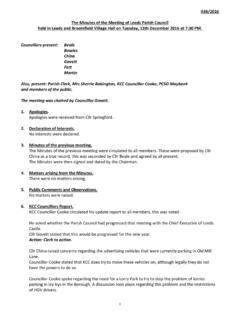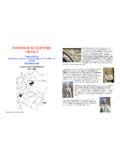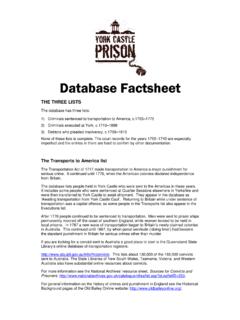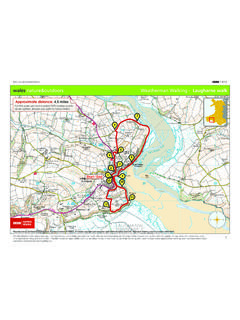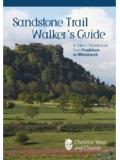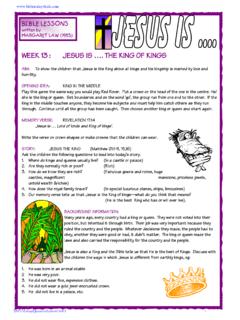Transcription of The Plantation of Ulster - enniskillencastle.co.uk
1 Page 1 ThePlantationofUlster :The Story ofCo. FermanaghA Teachers Aid produced byFermanagh County MuseumEducation for Key Stage 3 Fermanagh County MuseumEnniskillen CastleCastle BarracksEnniskillenCo. FermanaghN. IrelandBT74 7 HLTel: + 44 (0) 28 6632 5000 Fax: +44 (0) 28 6632 7342 Email: 2 The PlantationMedieval HistoryThe Anglo-Normans conquered Ireland inthe late 12th century and by 1250 controlledthree-quarters of the country including all thetowns. Despite strenuous efforts, they failedto conquer the north west of Ireland and thispart of Ireland remained in Irish hands untilthe end of the 16th century. The O Neills andO Donnells controlled Tyrone and Donegaland, from about 1300, the Maguires becamethe dominant clan in an area similar to thepresent county of Fermanagh. In the rest ofthe country Anglo Norman influence haddeclined considerably by the 15th century, their control at thattime extending only to the walled towns and to a small areaaround Dublin, known as the Pale.
2 However, from the middle ofthe 16th century England gradually extended its control over thecountry until the only remaining Gaelic stronghold was in thecentral and western parts of the Province of SocietyGaelic Ireland was a patchwork of independent kingdoms, eachruled by a chieftain and bound by a common set of social,religious and legal traditions. The legal system was called theBrehon Law and differed considerably from English law. Forexample, in English law succession normally passed to theeldest son but when an Irish chieftain died, his successor waselected from among many members of his clan, those whowere descended from a common Annals of UlsterThe Annals of Ulster , written in Fermanagh, is the mostimportant source for the early history of Ireland. It was begun bya remarkable church leader and scholar, Cathal MacManusMaguire in the late 15th century and covers the history of Irelandfrom the arrival of St.
3 Patrick in the 5th century until the 16thcentury. It is particularly informative about the MacManuses andabout the ruling Maguire chieftains of of a Maguire Chieftain at Cornashee, near Lisnaskea. Conjecturaldrawing by D Warner. Copyright of Fermanagh County stronghold at Lisnaskea in 15thcentury. Conjectural drawing by D of Fermanagh County 3 The Maguire ChieftainsThe Maguire chieftains originally ruledfrom their stronghold at traditional inauguration site is alarge earthen mound known as SciathGabhra at Cornashee, CastleThe first castle in Enniskillen wasbuilt in the early 15th century byHugh the Hospitable Maguire,younger brother of the rulingchieftain of Lisnaskea. The firstmention of Enniskillen castle isin 1439. The castle became theprincipal Maguire seat in 1484when Sean Maguire was elected chieftain of the life in Enniskillen castle was both comfortable andconvivial, probably much like medieval court life in London orDublin.
4 The poets, writing for the Maguires, describe themenfolk hunting withtheir dogs, ladies doingfine needlework andlooking after herbgardens and eveningsof feasting, music andpoetry at EnniskillenCastle. At the close ofthe 16th century, thisprivileged life came toan abrupt clan inauguration site Sciath Gabhra at Cornashee, courtesy of Stuart castle , Enniskillen. Conjecturaldrawing by Richard chieftain being entertained by harper and Derricke s Image of PlantationMaguire castle , Enniskillen. Conjecturaldrawing by D Warner. Copyright ofFermanagh County 4 The Role of Fermanagh in the Nine Years War 1594 - 1603 Queen Elizabeth I always feared that King Philip of Spain woulduse Ireland as a base to launch an attack against England. Toprevent this she determined to conquer the whole country -including its remote North. By 1590 Ulster had been divided intocounties and in Fermanagh land which had previouslybelonged to the Maguire chieftain was granted to him on theunderstanding that he would pay rent to the English Crown andobey English , the Ulster lords deeply resented this kind ofinterference and fought a war that was to last for nine years, toprevent the English taking control of their territory.
5 The first torebel was King Hugh Maguire of Fermanagh who in 1593 foughtthe English near the present town of Ballyshannon. In themonths that followed, both sides realised that whoever heldEnniskillen castle held the key to ultimate January 1594, the English made hasty preparations to attackEnniskillen castle . On the 26th January 1594 the castle cameunder siege and was continuously blasted by cannon. Six dayslater, the Englishlaunched a finalassault acrossthe water. Thesoldiers quicklybreached thecastle walls andpoured English heldEnniskillen Castlefor 15 months,and all that time the Maguires were close by, plotting to retake moment came in the spring of 1595. English troops weresent to bring food supplies to the castle . The Maguires andtheir supporters made a surprise attack on them before dawn asthey camped beside the Arney River. They routed them. TheKing Hugh Maguire, the first of the Irishlords to rebel in 1593.
6 Conjecturaldrawing by D. Warner. Copyright ofFermanagh County of Enniskillen castle , 1594 by John Thomas. Originalmap is in the British Soldiers from Derricke s Imageof IrelandThe PlantationPage 5scene of this attack became known as The Ford of the Biscuit because of all these provisions (biscuit was a kind of crisp drybread) left on the battlefield by the English. The Enniskillengarrison, with no fresh supplies, were faced with starvation andhad to Maguires once more ruled from Enniskillen castle but thewar against England had now spread throughout the wholecountry, led by Hugh O Neill, Earl of Tyrone. The Gaelic kingshad succeeded in getting support from the Spanish and theyfought the English in a last great battle at Kinsale in County Corkon Christmas Eve 1601. The English, under Lord Mountjoy,defeated Hugh O Neill, the Maguires and the combined Irish andSpanish defeat at Kinsale marked the final defeat of the Gaelicchieftains and in 1603 they made peace.
7 Four years later, theleading Irish chieftains, humiliated by defeat and apprehensivefor their future, decided to leave Ireland. In September 1607they set sail for France with their families never to return. Thisevent is known as the Flight of the Earls . Their lands werethen seized by the Crown and were subsequently given to newEnglish and Scottish settlers in the colonizing plan known as thePlantation of of UlsterKing James I believed that colonizing Ulster with loyal Britishsubjects would quell rebellion and win over the rude andbarbarous Irish to civility and Protestantism. This plan, knownas the Plantation of Ulster , enticed Protestant landowners andminor gentry from England and Scotland to settle in Ulster . Inreturn for grants of land they agreed to bring plenty of Britishworkers with them to build strong houses and to create played an indispensable role in the Plantation ofUlster by surveying the land confiscated by the Crown.
8 The bestknown cartographers in Ulster during this period and whosemaps still exist today, were Sir Thomas Raven and Sir JosiasBodley. In Fermanagh the maps made by Bodley in 1609 wereused to allocate land to the new settlers. They were not veryaccurate mainly because Bodley, an engineer and fortificationexpert, unaware that the Irish land measure was larger than theGaelic chieftain and followers fromDerricke s Image of Irish soldier from Derricke sImage of PlantationPage 6 English, recorded less land than 1610 legal preparations for the plantationwere completed and land throughout Ulsterwas distributed in the following way: *Undertakers received c. 40% **Servitors received c. 15% Native Irish received c. 20% The Church received c. 20%*Undertakers a landlord who was given alarge estate of land at a low rent in exchangefor an undertaking to settle ten English orScottish families on each 1000 acres of land received.
9 **Servitors Those who had had served the monarch as anofficial or a soldier in the Irish campaign. Servitors were allowedto let land to Irish in FermanaghIn Fermanagh, land was apportioned to Scottish and Englishundertakers and servitors. Land was also allocated to both thesenior and junior branch of the Maguires and to a number ofother Irish 1609, Enniskillen castle had become an English garrisonfort in the charge of Captain William Cole the newly appointedconstable. The castle , left in ruins by the Maguires was rebuiltby Cole and next to itCole built a house for hisfamily. Cole was aLondoner of Devonshirestock who had servedwith the Crown forces inIreland. He was grantedland to establish the newtown of Enniskillen andbrought over Englishsettlers with buildingskills. He provided themwith the necessary timber and raw materials to erect housesSir William Cole, Constable of Enniskillen courtesy of John Cathcart.
10 Enniskillen castle , Enniskillen c. drawing by Richard of the Barony Of Magheryboy, Co. Fermanagh by Sir JosiasBodley, of Enniskillen castle frommap of Ulster by John Speede,published in PlantationPage 7and all the required public of these early town buildingshave 1611, Sir George Carew reportedto the government on the work doneby William Cole at Enniskillen well as rebuilding the castle , Colehad raised the parapet wall from 14feet to 26 feet, added new flankersand built a wall-walk inside Watergate was built in 1611 andbeside it on the inside is a well. TheCastle remained the Cole familyresidence until 1710 when as a result of a fire, they moved tonearby Portora castle and later to a new country residence Town of EnniskillenThe town of Enniskillenwas established by acharter of King James Iin 1613, one of theeighteen new Ulsterboroughs withrepresentation in theDublin Parliament.

